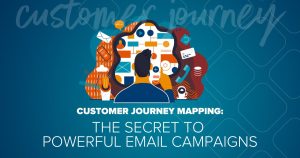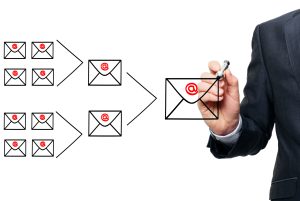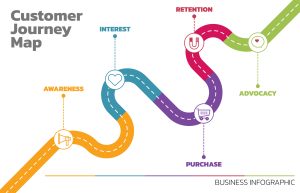
AI in Marketing: How to Leverage
the Growing Content Trend
(and Avoid Pitfalls)
Explore the pros and cons of AI in marketing. Discover how AI can revolutionize content strategies without losing your creativity…
Read More
Ever felt like your emails are getting lost in the black hole of inboxes? You craft compelling content, hit send, and…crickets. The culprit could be a disconnect between your emails and your customer’s journey. This is where customer journey mapping comes in, a powerful tool for crafting email sequences that resonate and drive results. In this blog post, learn how to create a customer journey map that yields high click-through rates and conversions.

Think of a customer journey map as a visual roadmap of a customer’s experience with your brand. It plots their touchpoints (website visits,
social media interactions, emails) across different stages: awareness, consideration, purchase, retention, and advocacy. By understanding this journey, you can tailor your email marketing to meet their needs at each step.
Here’s why mapping your customer journey is a game-changer for your email strategy:
 Ready to unleash the power of customer journey mapping? Here’s your step-by-step guide:
Ready to unleash the power of customer journey mapping? Here’s your step-by-step guide:
Begin building your customer journey map by creating buyer personas – detailed profiles representing your ideal customers. Consider demographics, interests, pain points, and preferred communication channels. (See example later in this post for a credit union customer.)
Pinpoint all the ways your potential and existing customers interact with your brand. This includes website visits, social media engagement, blog reads, and, of course, email interactions.
Visualize the customer journey for each buyer persona. Popular formats include flowcharts, timelines, or even customer avatars navigating a map. Each stage should highlight the following:
Now comes the magic! Based on your map, create automated email sequences that target each stage of the journey. Here are some email sequence examples:
The beauty of customer journey mapping is its iterative nature. You can track email performance metrics like open rates, click-through rates, and conversions, and then use this data to refine your content, subject lines, and send times for better results.
Contact Ironistic for Customer Journey Mapping!
Headlines are the first impression – make them count! Here are some tips:
There’s no magic formula, but research suggests certain times and days tend to have higher engagement:
Email campaign platforms will usually track and provide this data to you, so you can see over a certain time period, which days and times are working best for you.
 Buyer Persona: John, a recent college graduate with student loan debt and looking to build credit.
Buyer Persona: John, a recent college graduate with student loan debt and looking to build credit.
Subject Line: “Student Loan Got You Down? We Can Help!”
Content: Offers a free downloadable guide on student loan repayment strategies and highlights the credit union’s competitive interest rates for refinancing.
Subject Line: “Building Your Credit? Start Here!”
Content: Provides an infographic explaining credit scores and different ways to build credit. Promotes the credit union’s free credit score monitoring service.
Subject Line: “Pre-Approved! Your Path to a Credit Card Starts Here.”
Content: Offers John pre-approval for a low-interest credit card based on his initial inquiry. Explains the benefits of using the credit card responsibly to build credit.
Subject Line: “Welcome to [Credit Union Name], John!”
Content: Welcomes John and explains the benefits of membership, including online banking features and financial education resources. Offers a free budgeting tool to help him manage his finances.
Subject Line: “Planning a Dream Vacation? We’ve Got You Covered.”
Content: Highlights the credit union’s high-yield savings accounts and features a budgeting calculator to help John set financial goals. Offers a referral program with bonus rewards for recommending the credit union to friends.
By providing valuable information at every stage of the customer journey, the credit union builds trust with John and establishes itself as a reliable financial partner. This approach encourages John to choose the credit union for future financial needs and, hopefully, become a lifelong member.
Customer journey mapping is a powerful tool that empowers you to craft email marketing campaigns that resonate with your audience. By understanding their needs and tailoring your content accordingly, you can dramatically increase engagement, conversions, and customer lifetime value.
If you are interested in creating a customer journey map for your email campaigns, Ironistic can help. Our marketing specialists have extensive knowledge of email marketing and other integrated marketing strategies that can start you off on the right foot.
Contact Ironistic for Customer Journey Mapping!
Comments
There are currently no responses.